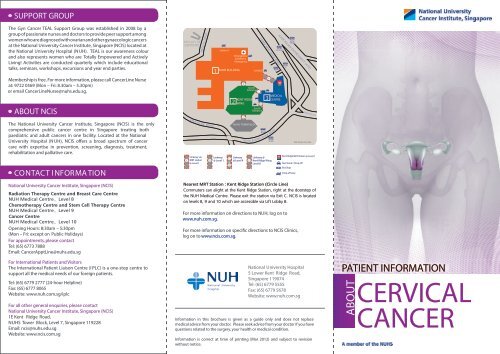Download a soft copy of the Cervical Cancer brochure in English
Download a soft copy of the Cervical Cancer brochure in English
Download a soft copy of the Cervical Cancer brochure in English
You also want an ePaper? Increase the reach of your titles
YUMPU automatically turns print PDFs into web optimized ePapers that Google loves.
SUPPORT GROUP<br />
The Gyn <strong>Cancer</strong> TEAL Support Group was established <strong>in</strong> 2008 by a<br />
group <strong>of</strong> passionate nurses and doctors to provide peer support among<br />
women who are diagnosed with ovarian and o<strong>the</strong>r gynaecologic cancers<br />
at <strong>the</strong> National University <strong>Cancer</strong> Institute, S<strong>in</strong>gapore (NCIS) located at<br />
<strong>the</strong> National University Hospital (N UH). TEAL is our awareness colour<br />
and also represents women who are Totally Empowered and Actively<br />
Liv<strong>in</strong>g! Activities are conducted quarterly which <strong>in</strong>clude educational<br />
talks, sem<strong>in</strong>ars, workshops, excursions and year end parties.<br />
Membership is free. For more <strong>in</strong>formation, please call <strong>Cancer</strong>L<strong>in</strong>e Nurse<br />
at: 9722 0569 (Mon – Fri: 8.30am – 5.30pm)<br />
or email <strong>Cancer</strong>L<strong>in</strong>eNurse@nuhs.edu.sg.<br />
ABOUT NCIS<br />
The National University <strong>Cancer</strong> Institute, S<strong>in</strong>gapore (NCIS) is <strong>the</strong> only<br />
comprehensive public cancer centre <strong>in</strong> S<strong>in</strong>gapore treat<strong>in</strong>g both<br />
paediatric and adult cancers <strong>in</strong> one facility. Located at <strong>the</strong> National<br />
University Hospital (N UH), NCIS a broad spectrum <strong>of</strong> cancer<br />
care with expertise <strong>in</strong> prevention, screen<strong>in</strong>g, diagnosis, treatment,<br />
rehabilitation and palliative care.<br />
MAIN BUILDING<br />
KENT RIDGE<br />
WING<br />
NUHS TOWER BLOCK<br />
MEDICAL<br />
CENTRE<br />
CONTACT I NFORMA TION<br />
National University <strong>Cancer</strong> Institute, S<strong>in</strong>gapore (NCIS)<br />
Radiation Therapy Centre and Breast Care Centre<br />
NUH Medical CentreLevel 8<br />
Chemo<strong>the</strong>rapy Centre and Stem Cell Therapy Centre<br />
NUH Medical CentreLevel 9<br />
<strong>Cancer</strong> Centre<br />
NUH Medical CentreLevel 10<br />
Open<strong>in</strong>g Hours: 8:30am – 5:30pm<br />
(Mon – Fri: except on Public Holidays)<br />
For appo<strong>in</strong>tments, please contact<br />
Tel: (65) 6773 7888<br />
Email: <strong>Cancer</strong>ApptL<strong>in</strong>e@nuhs.edu.sg<br />
For International Patients and Visitors<br />
The International Patient Liaison Centre (I PLC) is a one-stop centre to<br />
support all <strong>the</strong> medical needs <strong>of</strong> our foreign patients.<br />
Tel: (65) 6779 2777 (24-hour Helpl<strong>in</strong>e)<br />
Fax: (65) 6777 8065<br />
Website: www.nuh.com.sg/iplc<br />
For all o<strong>the</strong>r general enquiries, please contact<br />
National University <strong>Cancer</strong> Institute, S<strong>in</strong>gapore (NCIS)<br />
1E Kent Ridge Road,<br />
NUHS Tower Block, Level 7, S<strong>in</strong>gapore 119228<br />
Email: ncis@nuhs.edu.sg<br />
Website: www.ncis.com.sg<br />
For more <strong>in</strong>formation on directions to NUH, log on to<br />
www.nuh.com.sg.<br />
F<br />
log on to www.ncis.com.sg.<br />
National University Hospital<br />
5 Lower Kent Ridge Road,<br />
S<strong>in</strong>gapore 119074<br />
Tel: (65) 6779 5555<br />
Fax: (65) 6779 5678<br />
Website: www.nuh.com.sg<br />
Information <strong>in</strong> this <strong>brochure</strong> is given as a guide only and does not replace<br />
medical advice from your doctor. Please seek advice from your doctor if you have<br />
questions related to <strong>the</strong> surgery, your health or medical condition.<br />
Information is correct at time <strong>of</strong> pr<strong>in</strong>t<strong>in</strong>g (Mar 2012) and subject to revision<br />
without notice.<br />
PATIENT INFORMATION<br />
ABOUT<br />
CERVICAL<br />
CANCER
What is <strong>Cervical</strong> <strong>Cancer</strong>?<br />
The cervix is <strong>the</strong> lower part <strong>of</strong> <strong>the</strong> uterus (womb) connect<strong>in</strong>g <strong>the</strong> body<br />
<strong>of</strong> <strong>the</strong> uterus to <strong>the</strong> vag<strong>in</strong>a (birth canal). <strong>Cancer</strong> <strong>of</strong> <strong>the</strong> cervix can take<br />
many years to develop. Before cancer occurs, <strong>the</strong> cervix undergoes<br />
pre-cancerous phases. These pre-cancerous phases cause changes <strong>in</strong><br />
<strong>the</strong> cervix known as <strong>Cervical</strong> Intraepi<strong>the</strong>lial Neoplasia (CIN) and can<br />
develop to cancer if left untreated.<br />
What can you do to prevent<br />
<strong>Cervical</strong> <strong>Cancer</strong>?<br />
There are two ways to prevent cervical cancer:<br />
• Go for regular Pap smear test<br />
• Get vacc<strong>in</strong>ated aga<strong>in</strong>st <strong>the</strong> Human Papillomavirus (HPV)<br />
Uterus<br />
Brush<br />
How is <strong>Cervical</strong> <strong>Cancer</strong><br />
diagnosed?<br />
If you present with any <strong>of</strong> <strong>the</strong> symptoms mentioned, <strong>the</strong> doctor will<br />
perform a pelvic exam<strong>in</strong>ation and a biopsy <strong>of</strong> <strong>the</strong> cervix may be taken<br />
to look for cancer cells.<br />
What are <strong>the</strong> treatment<br />
options?<br />
There are different treatments available for cervical cancer depend<strong>in</strong>g<br />
on <strong>the</strong> stage <strong>of</strong> cervical cancer. Factors o<strong>the</strong>r than <strong>the</strong> stage <strong>of</strong> <strong>the</strong><br />
cancer that might have an impact on your treatment decision <strong>in</strong>clude<br />
your age, your overall health, and your own preferences. The three<br />
ma<strong>in</strong> types <strong>of</strong> treatment <strong>in</strong>clude surgery, radiation and chemo<strong>the</strong>rapy.<br />
Cervix<br />
Rectum<br />
Vag<strong>in</strong>a<br />
Surgery<br />
Surgery is usually <strong>the</strong> first treatment for cancer <strong>of</strong> <strong>the</strong> cervix <strong>in</strong> <strong>the</strong><br />
early stages (where cancer is conf<strong>in</strong>ed to <strong>the</strong> cervix). The most common<br />
treatment is hysterectomy to remove <strong>the</strong> uterus (womb) and cervix. The<br />
neighbour<strong>in</strong>g reproductive organs such as <strong>the</strong> ovaries and fallopian<br />
tubes may be removed. However this depends on o<strong>the</strong>r factors such<br />
as your age.<br />
Who is at risk?<br />
• Persistent Human Papillomavirus (HPV) <strong>in</strong>fection<br />
• Multiple sexual partners<br />
• Early onset <strong>of</strong> sexual <strong>in</strong>tercourse<br />
• Usage <strong>of</strong> oral contraceptives<br />
• Smok<strong>in</strong>g<br />
• History <strong>of</strong> sexually transmitted disease<br />
• Weakened immune system e.g. HIV <strong>in</strong>fection<br />
People who th<strong>in</strong>k <strong>the</strong>y may be at risk should discuss this with <strong>the</strong>ir doctor.<br />
What are <strong>the</strong> signs and<br />
symptoms?<br />
Early cervical cancer may not show any noticeable signs or symptoms.<br />
Below are some symptoms <strong>of</strong> cervical cancer although o<strong>the</strong>r conditions<br />
may also cause those symptoms:<br />
• Vag<strong>in</strong>al bleed<strong>in</strong>g (Between periods or after sexual <strong>in</strong>tercourse)<br />
• Blood-sta<strong>in</strong>ed vag<strong>in</strong>al discharge<br />
• Pa<strong>in</strong> dur<strong>in</strong>g sexual <strong>in</strong>tercourse<br />
A doctor should be consulted if <strong>the</strong> symptoms above occur.<br />
A pap smear test is a simple procedure where cells are collected from<br />
<strong>the</strong> surface <strong>of</strong> <strong>the</strong> cervix and <strong>the</strong>n sent to a laboratory to detect any<br />
abnormality. All sexually active women between 25 and 69 years<br />
old are advised to have a pap smear test regularly (every 3 years on<br />
average).<br />
If you have an abnormal pap smear, <strong>the</strong> doctor may do any <strong>of</strong> <strong>the</strong><br />
follow<strong>in</strong>g:<br />
• Colpos<strong>copy</strong><br />
The doctor uses a colposcope (a lighted, magnify<strong>in</strong>g <strong>in</strong>strument)<br />
to check <strong>the</strong> vag<strong>in</strong>a and cervix for abnormal areas. It is not <strong>in</strong>serted<br />
<strong>in</strong>to <strong>the</strong> vag<strong>in</strong>a.<br />
• Cone Biopsy<br />
If <strong>the</strong> abnormal area cannot be seen properly with <strong>the</strong> colposcope,<br />
a cone biopsy may be carried out. The doctor will remove a coneshaped<br />
sample <strong>of</strong> tissue for <strong>the</strong> pathologist to exam<strong>in</strong>e under a<br />
microscope for any abnormal cells. This procedure is <strong>of</strong>ten done<br />
under a general anaes<strong>the</strong>tic.<br />
<strong>Cervical</strong> cancer is caused by a common virus called <strong>the</strong> Human<br />
Papillomavirus (HPV). Be<strong>in</strong>g vacc<strong>in</strong>ated aga<strong>in</strong>st HPV is recommended<br />
for all young women aged 10 to 25. Ideally <strong>the</strong> vacc<strong>in</strong>e should be given<br />
before <strong>the</strong> first sexual contact. Currently available HPV vacc<strong>in</strong>es are<br />
given as three <strong>in</strong>jections over a six-month period.<br />
Some patients with <strong>the</strong> earliest stage cervical cancers can be treated<br />
with cervical conisation (cone biopsy) or simple hysterectomy alone.<br />
Radiation Therapy<br />
Radiation <strong>the</strong>rapy is a cancer treatment that uses high energy x-rays<br />
or o<strong>the</strong>r types <strong>of</strong> radiation to kill cancer cells or to keep <strong>the</strong>m from<br />
grow<strong>in</strong>g. There are two types <strong>of</strong> radiation <strong>the</strong>rapy – external and<br />
<strong>in</strong>ternal. The way <strong>the</strong> radiation <strong>the</strong>rapy is given depends on <strong>the</strong> type<br />
and stage <strong>of</strong> <strong>the</strong> cancer be<strong>in</strong>g treated.<br />
Radiation can be used after surgery for early stage cervical cancer. It is<br />
also <strong>the</strong> ma<strong>in</strong> treatment for later stage (stage 2 and above) cancers. For<br />
cervical cancer, when radiation is <strong>the</strong> ma<strong>in</strong> treatment, it is <strong>of</strong>ten given<br />
along with low doses <strong>of</strong> chemo<strong>the</strong>rapy for it to work better.<br />
Chemo<strong>the</strong>rapy<br />
Chemo<strong>the</strong>rapy is <strong>the</strong> use <strong>of</strong> drugs to help kill cancer cells and shr<strong>in</strong>k <strong>the</strong><br />
size <strong>of</strong> <strong>the</strong> tumour. It is <strong>of</strong>ten comb<strong>in</strong>ed with radiation <strong>the</strong>rapy. Usually<br />
<strong>the</strong> drugs are given <strong>in</strong>to a ve<strong>in</strong>. Once <strong>the</strong> drugs enter <strong>the</strong> bloodstream,<br />
<strong>the</strong>y spread throughout <strong>the</strong> body. In cervical cancer, chemo<strong>the</strong>rapy is<br />
also given to women with advanced or recurrent cancer.









